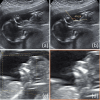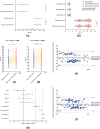Automatic measurement of fetal anterior neck lower jaw angle in nuchal translucency scans
- PMID: 38438512
- PMCID: PMC10912614
- DOI: 10.1038/s41598-024-55974-x
Automatic measurement of fetal anterior neck lower jaw angle in nuchal translucency scans
Abstract
This study aims at suggesting an end-to-end algorithm based on a U-net-optimized generative adversarial network to predict anterior neck lower jaw angles (ANLJA), which are employed to define fetal head posture (FHP) during nuchal translucency (NT) measurement. We prospectively collected 720 FHP images (half hyperextension and half normal posture) and regarded manual measurement as the gold standard. Seventy percent of the FHP images (half hyperextension and half normal posture) were used to fit models, and the rest to evaluate them in the hyperextension group, normal posture group (NPG), and total group. The root mean square error, explained variation, and mean absolute percentage error (MAPE) were utilized for the validity assessment; the two-sample t test, Mann-Whitney U test, Wilcoxon signed-rank test, Bland-Altman plot, and intraclass correlation coefficient (ICC) for the reliability evaluation. Our suggested algorithm outperformed all the competitors in all groups and indices regarding validity, except for the MAPE, where the Inception-v3 surpassed ours in the NPG. The two-sample t test and Mann-Whitney U test indicated no significant difference between the suggested method and the gold standard in group-level comparison. The Wilcoxon signed-rank test revealed significant differences between our new approach and the gold standard in personal-level comparison. All points in Bland-Altman plots fell between the upper and lower limits of agreement. The inter-ICCs of ultrasonographers, our proposed algorithm, and its opponents were graded good reliability, good or moderate reliability, and moderate or poor reliability, respectively. Our proposed approach surpasses the competition and is as reliable as manual measurement.
© 2024. The Author(s).
Conflict of interest statement
The authors declare no competing interests.
Figures





Similar articles
-
Intra- and interoperator reliability of manual and semi-automated measurement of fetal nuchal translucency by sonographers with different levels of experience.Ultrasound Obstet Gynecol. 2010 Oct;36(4):417-22. doi: 10.1002/uog.8809. Ultrasound Obstet Gynecol. 2010. PMID: 20734371
-
Reliability of manual and semi-automated measurements of nuchal translucency by experienced operators.Int J Gynaecol Obstet. 2013 Jun;121(3):240-2. doi: 10.1016/j.ijgo.2013.01.019. Epub 2013 Mar 15. Int J Gynaecol Obstet. 2013. PMID: 23499134
-
New technique for automatic sonographic measurement of change in head-perineum distance and angle of progression during active phase of second stage of labor.Ultrasound Obstet Gynecol. 2020 Oct;56(4):597-602. doi: 10.1002/uog.21963. Ultrasound Obstet Gynecol. 2020. PMID: 31909525
-
Diagnosis and management of fetal nuchal translucency.Semin Roentgenol. 1998 Oct;33(4):333-8. doi: 10.1016/s0037-198x(98)80040-0. Semin Roentgenol. 1998. PMID: 9800243 Review.
-
Whole exome sequencing in fetuses with isolated increased nuchal translucency: a systematic review and meta-analysis.J Matern Fetal Neonatal Med. 2023 Dec;36(1):2193285. doi: 10.1080/14767058.2023.2193285. J Matern Fetal Neonatal Med. 2023. PMID: 37019452
Cited by
-
An attentional mechanism model for segmenting multiple lesion regions in the diabetic retina.Sci Rep. 2024 Sep 12;14(1):21354. doi: 10.1038/s41598-024-72481-1. Sci Rep. 2024. PMID: 39266650 Free PMC article.
-
Proposing a machine learning-based model for predicting nonreassuring fetal heart.Sci Rep. 2025 Mar 6;15(1):7812. doi: 10.1038/s41598-025-92810-2. Sci Rep. 2025. PMID: 40050357 Free PMC article.
-
EEG-based optimization of eye state classification using modified-BER metaheuristic algorithm.Sci Rep. 2024 Oct 18;14(1):24489. doi: 10.1038/s41598-024-74475-5. Sci Rep. 2024. PMID: 39424849 Free PMC article.
-
Cost-effectiveness analysis of AI-based image quality control for perinatal ultrasound screening.BMC Med Educ. 2024 Dec 18;24(1):1437. doi: 10.1186/s12909-024-06477-w. BMC Med Educ. 2024. PMID: 39696216 Free PMC article. Clinical Trial.
-
New ultrasound features in diagnosing fetal anal atresia: a multicenter prospective cohort study.Sci Rep. 2024 Oct 1;14(1):22821. doi: 10.1038/s41598-024-73524-3. Sci Rep. 2024. PMID: 39354020 Free PMC article.
References
-
- Spencer K, Souter V, Tul N, Snijders R, Nicolaides KH. A screening program for trisomy 21 at 10–14 weeks using fetal nuchal translucency, maternal serum free beta-human chorionic gonadotropin and pregnancy-associated plasma protein-A. Ultrasound Obstet. Gynecol. 1999;13:231–237. doi: 10.1046/j.1469-0705.1999.13040231.x. - DOI - PubMed
-
- Lee Y-B, Kim M-H. Automated ultrasonic measurement of fetal nuchal translucency using dynamic programming. In: Martínez-Trinidad JF, Carrasco Ochoa JA, Kittler J, editors. Progress in Pattern Recognition, Image Analysis and Applications. Springer; 2006. pp. 157–167.
MeSH terms
Grants and funding
- B202309026062/Health Research Project of Hunan Provincial Health Commission
- 20200951/Health Research Project of Hunan Provincial Health Commission
- B2019030/Health Research Project of Hunan Provincial Health Commission
- 2023RX21/Ruixin project of Hunan Provincial Maternal and Child Health Care Hospital
- 2019SK1010/Major Scientific and Technological Projects for collaborative prevention and control of birth defects in Hunan Province, China
LinkOut - more resources
Full Text Sources
Research Materials

